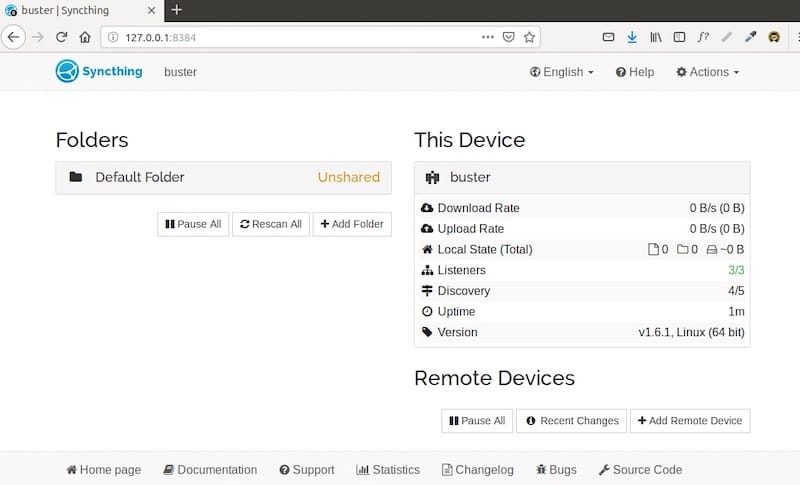How To Install Syncthing on openSUSE

In today’s digital landscape, maintaining seamless file synchronization across multiple devices is crucial. Syncthing emerges as a powerful, open-source solution, offering secure and decentralized file synchronization. This guide provides a detailed walkthrough on how to install Syncthing on openSUSE, ensuring your data remains private and accessible across all your devices.
Understanding Syncthing
Syncthing is a continuous file synchronization program. It synchronizes files between two or more computers in real time, safely protected from prying eyes. Your data is your data alone and you deserve to choose where it is stored, whether it is shared with some third party, and how it’s transmitted over the internet. This tool stands out due to its decentralized nature, meaning there’s no central server holding your data. Instead, data is directly shared between your devices, giving you complete control over your information.
Key Features and Capabilities
- Decentralization: No central server means no single point of failure or control.
- Security: Encrypted communication ensures your data is protected from eavesdropping.
- Cross-Platform Compatibility: Works seamlessly across various operating systems, including Windows, macOS, Linux, and more.
- Real-Time Synchronization: Changes are synced instantly across devices.
- Open Source: The open protocol and open source code promotes transparency and community-driven development.
Syncthing vs. Other File Synchronization Solutions
While solutions like Dropbox and Google Drive offer convenience, they rely on centralized servers, raising privacy concerns. Syncthing, on the other hand, ensures your data remains on your devices, providing a more secure and private alternative. This makes it an excellent choice for users who prioritize data sovereignty and security.
System Requirements for openSUSE
Before installing Syncthing, ensure your openSUSE system meets the following requirements:
- An active internet connection for downloading packages.
- A user account with
sudoprivileges for administrative tasks. - Sufficient disk space for the Syncthing application and synchronized files.
Installation Methods
There are several ways to install Syncthing on openSUSE. We’ll cover the most common and reliable methods.
Official Repository Method
The easiest way to install Syncthing is via openSUSE’s official repositories. This method ensures you receive updates automatically through the system’s package manager.
Using Zypper Package Manager
Zypper is openSUSE’s command-line package manager. Follow these steps to install Syncthing:
- Open Terminal: Launch your terminal application.
- Install Syncthing: Execute the following command:
sudo zypper install syncthingThis command downloads and installs Syncthing from the official repositories.
- Verify Installation: Confirm the installation by checking the Syncthing version:
syncthing --version
Installing Syncthing-GTK for GUI Interface
While Syncthing primarily uses a web-based interface, syncthing-gtk provides a native GUI, enhancing user experience.
- Install Syncthing-GTK: Run the following command:
sudo zypper install syncthing-gtk - Launch Syncthing-GTK: Find it in your application menu and launch it.
Manual Repository Addition
If the official repositories don’t have the latest version, you can add a specific repository manually.
Commands for Different openSUSE Versions
Depending on your openSUSE version, use the appropriate commands:
openSUSE Tumbleweed
sudo zypper addrepo https://download.opensuse.org/repositories/network/openSUSE_Tumbleweed/network.repo
sudo zypper refresh
sudo zypper install syncthingopenSUSE Leap 15.x
Replace 15.x with your specific version (e.g., 15.6, 15.7):
sudo zypper addrepo https://download.opensuse.org/repositories/network/15.x/network.repo
sudo zypper refresh
sudo zypper install syncthingopenSUSE Factory PowerPC and ARM
sudo zypper addrepo https://download.opensuse.org/repositories/network/openSUSE_Factory_PowerPC/network.repo
sudo zypper refresh
sudo zypper install syncthingsudo zypper addrepo https://download.opensuse.org/repositories/network/openSUSE_Factory_ARM/network.repo
sudo zypper refresh
sudo zypper install syncthingInitial Configuration
After installation, some initial configurations are necessary to optimize Syncthing for your needs.
First-Run Wizard Walkthrough
When you first launch Syncthing, it opens a web-based GUI in your default browser. A first-run wizard guides you through basic settings.
- Firewall Configuration: Syncthing prompts you to allow connections through your firewall. Accept this to enable synchronization across your network.
- Usage Reporting: You’re asked whether to enable anonymous usage reporting. This helps the developers improve Syncthing. Choose your preference.
Configuration File Location
Syncthing’s configuration files are stored in the ~/.config/syncthing directory. This directory contains the config.xml file, which stores all settings.
Setting Up User Authentication
To prevent unauthorized access, set up a username and password for the web GUI.
- Access Web GUI: Open your browser and navigate to
http://localhost:8384. - Settings: Go to “Actions” (top right) and select “Settings”.
- GUI Tab: Enter a username and password in the “GUI Authentication” section.
- Save: Click “Save” to apply the changes.
Network Listening Configuration
By default, Syncthing listens on all network interfaces. To restrict this, modify the listening address.
- Edit
config.xml: Open~/.config/syncthing/config.xmlin a text editor. - Modify Address: Change the
<address>tag to127.0.0.1:8384to listen only on localhost. - Restart Syncthing: Restart the Syncthing service for changes to take effect.
Port Configuration
Syncthing uses several ports for communication. Ensure these ports are open in your firewall.
- 22000 (TCP): For device-to-device communication.
- 21027 (UDP): For local discovery.
- 8384 (TCP): For the web GUI.
To open these ports using ufw, run:
sudo ufw allow 22000/tcp
sudo ufw allow 21027/udp
sudo ufw allow 8384/tcpSystem Integration
Integrating Syncthing with systemd ensures it starts automatically on boot.
SystemD Service Setup
systemd is a system and service manager for Linux. Setting up Syncthing as a service ensures it runs in the background and starts automatically.
Enabling Syncthing Service
- Enable Service: Run the following command:
sudo systemctl enable syncthing@$USER.serviceReplace
$USERwith your username. - Start Service: Start the service with:
sudo systemctl start syncthing@$USER.service - Check Status: Verify the service is running:
sudo systemctl status syncthing@$USER.service
User-Specific Service Configuration
systemd allows you to run Syncthing as a specific user, enhancing security.
- Create Service File: Create a copy of the default service file:
sudo cp /usr/lib/systemd/system/syncthing@.service /etc/systemd/system/syncthing@$USER.serviceReplace
$USERwith your username. - Edit Service File: Open the file in a text editor and ensure the
User=andGroup=directives are set to your username. - Reload Daemon: Reload the
systemddaemon:sudo systemctl daemon-reload - Enable and Start: Enable and start the service as described above.
Basic Usage Guide
Now that Syncthing is installed and configured, let’s explore its basic usage.
Accessing the Web Interface
The primary way to interact with Syncthing is through its web interface.
- Open Browser: Open your web browser.
- Navigate: Go to
http://localhost:8384. If you’re accessing it remotely, use the server’s IP address:http://<server-ip>:8384. - Login: Enter the username and password you configured earlier.

Adding Sync Folders
To synchronize files, you need to add folders to Syncthing.
- Add Folder: In the web GUI, click “Add Folder” at the bottom.
- Folder ID: Give the folder a unique ID. This ID is used to identify the folder across devices.
- Folder Path: Enter the path to the folder you want to synchronize.
- Sharing: Specify which devices you want to share the folder with.
- Save: Click “Save” to add the folder.
Setting Up Device Connections
For devices to sync, they need to be connected to each other.
- Get Device ID: On each device, go to “Actions” and select “Show ID”. This displays the device ID, a long string of characters.
- Add Remote Device: On one device, click “Add Remote Device”.
- Enter Device ID: Enter the device ID of the other device.
- Name: Give the device a name for easy identification.
- Sharing: Specify which folders you want to share with this device.
- Save: Click “Save” to add the device.
- Repeat: Repeat these steps on the other device, adding the first device’s ID.
Managing Shared Folders
Once devices are connected, you can manage shared folders.
- Folder Settings: Click on a folder in the web GUI to access its settings.
- Edit Devices: Modify which devices share the folder.
- Rescan Interval: Adjust how often Syncthing scans the folder for changes.
- Version Control: Configure versioning to keep track of file changes.
Advanced Configuration
Syncthing offers advanced options for fine-tuning its behavior.
Security Settings
Enhance security with these settings:
- TLS Encryption: Syncthing uses TLS for all communication, ensuring data is encrypted in transit.
- Device IDs: Only devices with the correct ID can connect, preventing unauthorized access.
Remote Access Setup
To access Syncthing remotely, configure port forwarding on your router.
- Port Forwarding: Forward port 8384 (or your custom port) to your server’s internal IP address.
- Firewall: Ensure your firewall allows connections to the forwarded port.
- Access: Access the web GUI via
http://<your-public-ip>:8384.
Bandwidth Limitations
Limit bandwidth usage to prevent Syncthing from consuming all your network resources.
- Settings: Go to “Actions” and select “Settings”.
- Networking: Set the “Global Discovery Server” to “false” to prevent Syncthing from using relay servers.
- Rate Limiting: Configure send and receive rate limits in the “Networking” section.
Versioning Configuration
Enable versioning to keep a history of file changes.
- Folder Settings: Click on a folder in the web GUI.
- Versioning: Choose a versioning mode:
- Simple: Keeps a specified number of recent versions.
- Staggered: Keeps versions at increasing intervals.
- External: Uses an external script for versioning.
- Configure: Set the desired options for your chosen versioning mode.
Ignore Patterns
Use ignore patterns to prevent certain files from being synchronized.
- Folder Settings: Click on a folder in the web GUI.
- Edit Ignore Patterns: Add patterns to exclude files, such as
*.tmpor/temp/. - Save: Click “Save” to apply the changes.
Troubleshooting
Here are some common issues and their solutions.
Common Installation Issues
- Dependency Errors: Ensure all dependencies are installed. Use
zypper install -f <package-name>to fix broken dependencies. - Repository Issues: Verify the repository URL is correct and the repository is enabled.
Service Startup Problems
- Permissions: Ensure the Syncthing user has proper permissions to access the configuration directory and synchronized folders.
- Firewall: Verify that the necessary ports are open in your firewall.
Connection Difficulties
- Device IDs: Double-check that device IDs are entered correctly on both devices.
- Firewall: Ensure firewalls on both devices allow Syncthing traffic.
- Network: Verify that devices are on the same network or can reach each other over the internet.
Log File Locations
Syncthing’s log files can provide valuable information for troubleshooting. The default location is in the configuration directory: ~/.config/syncthing/syncthing.log.
Performance Optimization
Optimize Syncthing’s performance with these tips.
Resource Usage Considerations
- CPU Usage: Limit the number of CPU cores Syncthing can use via the
-cpuprofileflag. - Memory Usage: Monitor memory usage and adjust settings accordingly.
Network Optimization
- Limit Bandwidth: Set send and receive rate limits to prevent network congestion.
- Disable Relays: If devices are on the same network, disable relay servers to improve speed.
Folder Scanning Optimization
- Rescan Interval: Adjust the rescan interval to balance real-time synchronization with resource usage.
- Ignore Patterns: Use ignore patterns to exclude unnecessary files, reducing scanning time.
Maintenance and Updates
Keep Syncthing updated to ensure optimal performance and security.
Keeping Syncthing Updated
Use the following command to update Syncthing:
sudo zypper update syncthingBackup Considerations
Regularly back up your Syncthing configuration and synchronized folders to prevent data loss.
System Integration Maintenance
Periodically check the systemd service to ensure it is running correctly and automatically starting on boot.
Congratulations! You have successfully installed Syncthing. Thanks for using this tutorial for installing the Syncthing on openSUSE system. For additional help or useful information, we recommend you check the official Syncthing website.